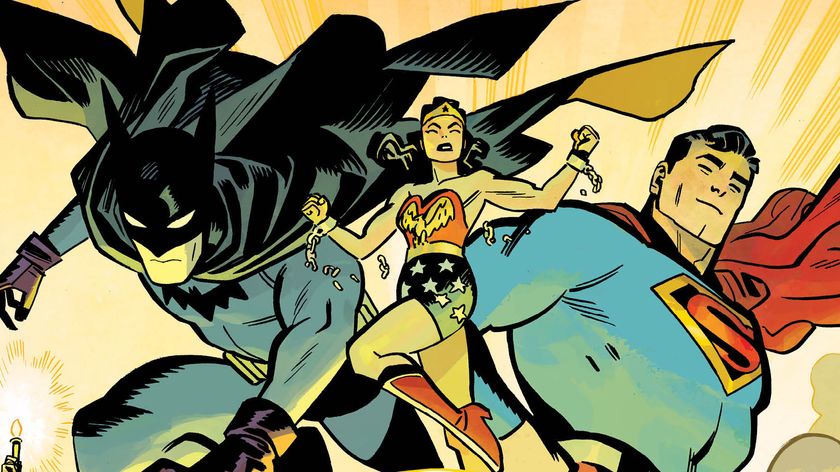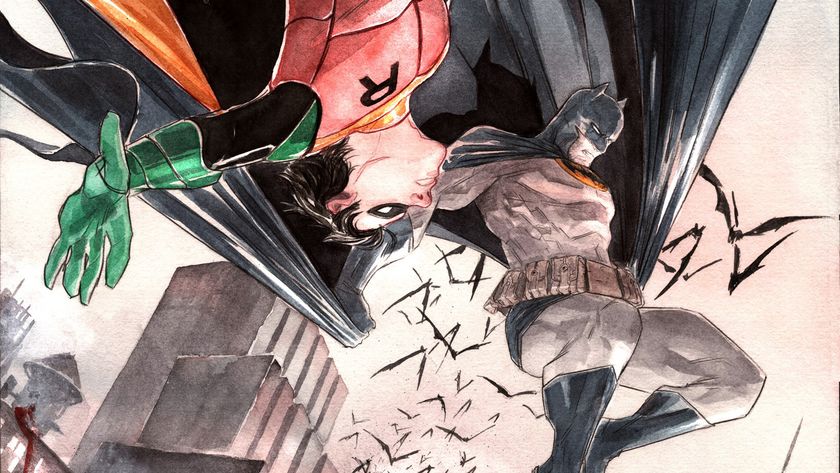Jock strips Batman of all of his toys for 'fresh but classic' One Dark Knight
Jock goes in-depth about the creation of his Black Label Batman series One Dark Knight
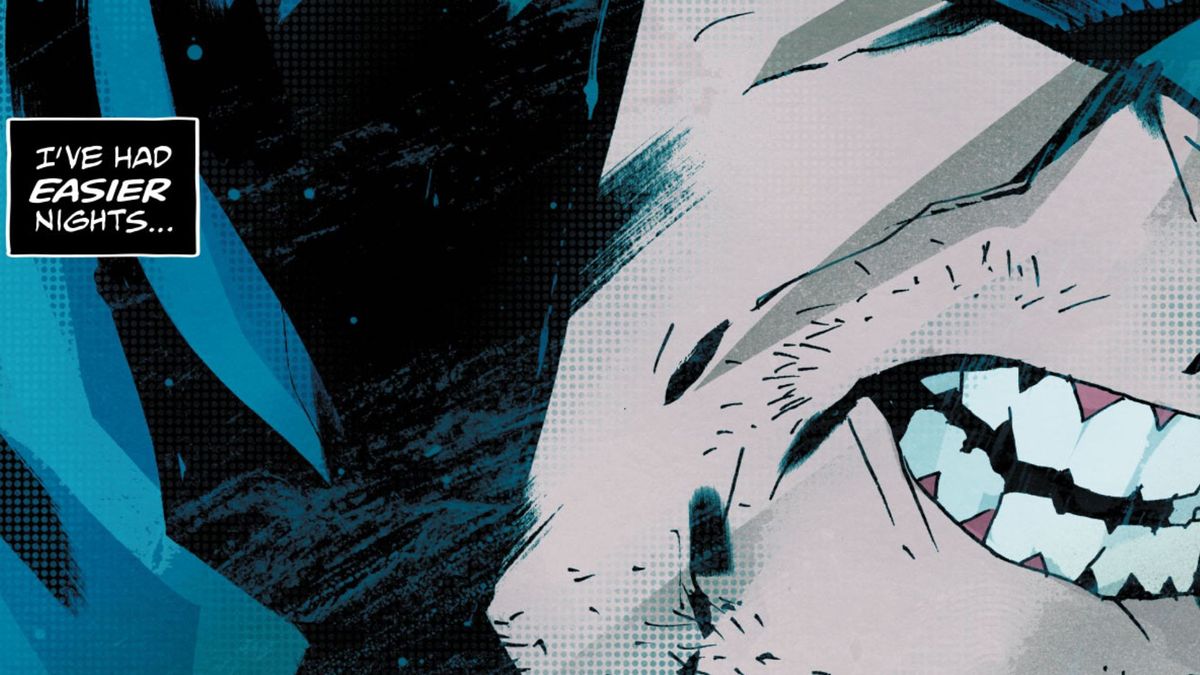
Batman has always been known as an action hero, from the Bam! Zap! Pows!s of the 1966 show to his back-breaking battle with Bane in Knightfall. And yet, in his eight decades of existence, few creators have leaned into the action of his character more than fan-favorite artist and DC regular Jock, with his three-book Black Label title Batman: One Dark Knight.
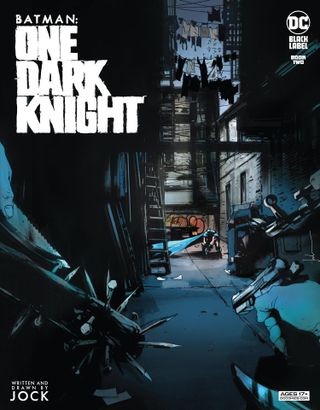
One Dark Knight takes place entirely over the course of one harrowing journey from Arkham Asylum to Blackgate prison, as the Dark Knight has to fend off waves of roving gangs and protect an ailing metahuman in his care. Before the release of Book Two, Newsarama had the chance to sit down with the creator to talk about his inspirations, how he views his characters, and what the future of the series holds. Read on for more.
Grant DeArmitt for Newsarama: Jock, I wanted to start by talking about the maps of Gotham you include in One Dark Knight. They're extremely detailed, and they give the reader such a good idea of the journey Batman needs to make. Can you tell us about creating those?
Jock: This is an action story, really. It's about Batman having a very hard time getting from A to B. One of the things that I think is really important in clear action storytelling is getting a sense of geography. Too often you see, in films, for example, just stuff happening and you just don't really get a sense of what the stakes are and where the various players are. I always love stuff that presents that clearly.
I wanted to nail down that he needs to get from here to here and this is what's going to happen to him in between. The map is a very simple thing, but it just seemed to make sense for the story that I was trying to tell. The various districts on the map help inspire certain themes and set pieces from the areas of Gotham that I could draw information from. And that's the [DC] canon map, by the way. It was fortuitous that when I looked at the map, Arkham Asylum is on the top left, and Blackgate is on the bottom right. So it's the perfect comic page flow, the same direction of reading. It all kind of fell into place. I thought, "I don't need to change this at all."

Nrama: That's so interesting to hear that it's the canon map because that's years of comic book history distilled into one thing. But, there is one part of this story that's entirely your own, the villainous character of Edward M. Pressler, AKA E.M.P. Can you tell us what inspired this character? And what's it like to pitch a new member of the Batman rogues gallery to DC?
Jock: Well, E.M.P. came about from how I was framing the story to myself. He's a guy who feeds on energy. It causes him to overload and that's what causes the blackout. So he's a little bit of a MacGuffin. And you're right, he is framed as a villain to begin with but we find out that he's more of a tragic character actually. Certainly, in his earlier years, he was hired by the mob to do nefarious things, so he definitely has a criminal background. But he's almost past his sell-by date because he's gotten too unstable to volatile and too dangerous.
Comic deals, prizes and latest news
Get the best comic news, insights, opinions, analysis and more!
But there's an element of redemption there too. In Book Two, we learn about the fact that E.M.P. has a son, which is very important.
As far as pitching to DC, it was a very smooth process. I told them I had the germ of this idea that there would be this new villain that fed on energy. And they said, "Absolutely, great." In fact, E.M.P. was only ever his holding name, a name you give because it describes him really simply. But then Chris Conroy, my editor, might have written it into a sort of solicitation text. I was like, "Oh I have always been meaning to come up with a new name for that guy." Chris said, "I thought that was his name," and then I realized maybe that is his name. Sometimes the thing that just sticks is the right thing to go with. I named him Edward M. Pressler in the style of classic Batman comics. You know, that his real name hints at his villain name.
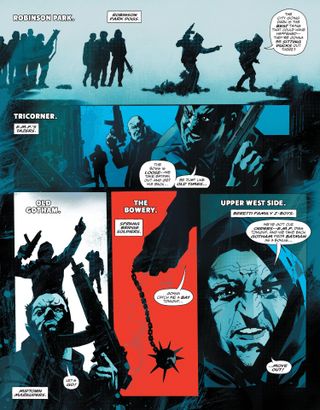
Nrama: Yeah! That feels so classic Gotham to me.
Jock: I liked that, yeah. With Batman's blue cape, too, I wanted this to feel very classic. But hopefully, bring a fresh spin on it.
Nrama: Alright, so as you said, E.M.P. is less of a villain, more of a MacGuffin. It seems to me like the real villains of this book are the gangs of Gotham. Can you talk for a minute about what drives these gangs? What's their relationship with each other?
Jock: The movie The Warriors was definitely an inspiration. There's something about that film getting some characters from point A to point B safely with the danger of the various gangs that definitely spoke to this story as well. The idea is that the call has gone out to all of the gangs of Gotham that E.M.P. needs taking out. And if Batman's with him, that's even better. The basic idea is that the gangs are almost one unit of threat. It's almost like a zombie film. There's always stuff out there trying to get you. There's something that I liked about that level of threat.
But these guys have rivalries too. They jostle for territory and position and power and everything else. Besides that, there's also E.M.P.'s former gang, who are trying to get him back alive.
Nrama: In the best way possible, the story feels very much like a video game. You're so aware of what the challenges are. In fact, Batman makes a comment that says, "I'm running low on tools in my belt." Why take this approach to telling a Batman story?
Jock: You know, there are stories that investigate Batman's psyche and everything, but I wanted a challenge that's more physical. He's being stripped of all his toys. The blackout happens and he starts to use up all of his utility belt… utensils? That's the wrong word [laughs]. He's not cooking a steak.
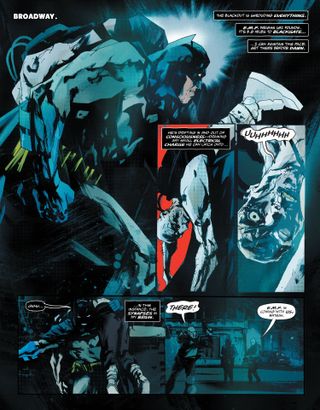
Batman maybe comes to realize that he's maybe been relying on that stuff too much. That he's ok without it. The city's in full blackout, and Book Two ends with him going underground, getting even darker. But it ends with him smiling because he realizes that this is what he's built for. "This is actually fine. This is actually who I am."
Nrama: I'm glad you brought up the point of the story where Batman goes below Gotham. What's that going to look like in Book Three? Is he going to be underground the whole time?
Jock: In the beginning of Book Three he's underground, looking to get E.M.P. back. And then he meets…
Nrama: Yes?
Jock: I was very wary to go into too many of the rogues' gallery for this story. I needed to keep it a little bit more "street-level." But in fact, he does meet someone down there, someone who challenges him even more physically.
Nrama: So you're confirming that Condiment King is making an appearance in One Dark Knight Book Three?
Jock: Yep. Finally, he's back.
Nrama: Stepping away from the story a little bit, I do want to talk about your process. This is your first writing gig for DC right?
Jock: I did a short story for Vertigo, in an anthology called CMYK. My friend Lee Garbett and I used to share a studio, and we co-wrote that. It was a little six-issue thing, so this is the first substantial story for sure.
Nrama: Are you finding many differences between working on your own as opposed to working with a different writer?
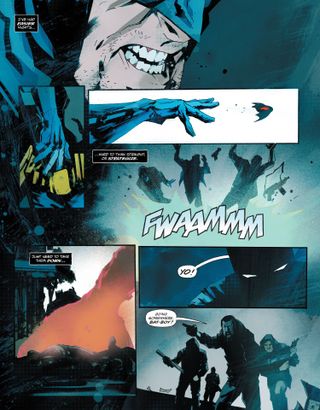
Jock: I don't think my art process has changed really. The only difference is that I'm essentially writing by laying the story out visually, I'm doing thumbnails, which I would not do with another writer. I seem to operate best when I'm figuring out the rhythm, the pace of the scenes. Because firstly, I'm an artist, and that is the skill that comes naturally to me. So I'm actually almost working "Marvel style." Sorry DC.
Nrama: We'll censor it, don't worry.
Jock: Good, thank you. But we all know that phrase, and that's almost what I'm doing for myself. It's quite an organic way of working. And it's what seems to work best for me.
Nrama: So you wouldn't say there's a traditional script you're working off of?
Jock: No, the only script that exists is the dialogue that I send to [letterer] Clem Robins. In fact, the way that I'm doing the dialogue is by doing temporary letters on the art, just to get a sense of how the page reads. I was trying to look at how Cliff Chiang's doing it with Catwoman: Lonely City. He's lettering that himself, and we chatted about the possibility of me maybe doing that at one point. But luckily, Clem stepped in. So I'm sort of writing it essentially with visual lettering on the page.
Nrama: Speaking of lettering, whose idea was it to have Batman's dialogue in all black?
Jock: That was mine.
Nrama: What's the inspiration there?
Jock: I'm a big fan of graphic design, visual things that give you a sense of what's going on. Though, since starting on this book, I randomly picked up Grant Morrison and Dave McKean's Arkham Asylum: A Serious House on Serious Earth. And I realized that Batman's balloons are black with white lettering. So maybe that was in there somewhere subconsciously? It certainly wasn't conscious when I made that decision. It just felt right to me. That's how he would be. So we just went with it. Then luckily DC was very supportive again and had no problem.
Nrama: Yeah, it makes so much sense. I feel like coming out of this book, it might look weird the next time I read Batman's dialogue and it's just normal.
Jock: I'll take that. That's fine. I'll ruin everyone else's reading experience if I have to.
Nrama: [Laughs] Okay, so I'm moving back to art. There are so many great full-page spreads and splash pages in this book. As you're constructing this story, how can you tell what makes a moment a splash page moment?
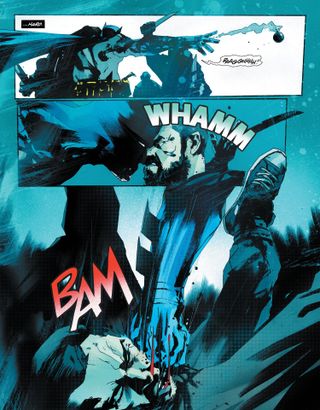
Jock: One of my first regular partners in crime was Andy Diggle, who wrote The Losers and Green Arrow: Year One. I met him as the editor of 2000 AD, he gave me my first work in comics. We became good friends and we worked on a lot of books together. I would say that Andy writes arguably the best action in comics. He's got such a good sense of pace and rhythm in a scene, and he is the king of the splash page. He knows the moments, exactly what you're talking about, the little things in the story that deserve a bullet point. Something that makes it a fully dramatic moment. Andy is amazing at that, and we always seem to sense those moments similarly.
I sort of took that. For me, this story was about showing Gotham in a certain light. It was about showing Batman in a certain light. It's about picking those moments that hopefully will help bring the reader in and draw them into this dark world.
Nrama: It certainly does. Ok, last question for you. This is a Black Label series, it stands on its own in so many ways. As you're heading into the end with Book Three, are you thinking you want to come back to this specific Gotham?
Jock: I would love to. I've spoken briefly to my editor about that. Let's see how this one does and see if it's viable and everything, but I do already have an idea in mind. I'd love to get the chance to tell it.
Batman: One Dark Knight Book Two is available on comic shelves and digital platforms everywhere March 29th.
Want more recommendations for great Batman stories? Newsarama has you covered.

Grant DeArmitt is a NYC-based writer and editor who regularly contributes bylines to Newsarama. Grant is a horror aficionado, writing about the genre for Nightmare on Film Street, and has written features, reviews, and interviews for the likes of PanelxPanel and Monkeys Fighting Robots. Grant says he probably isn't a werewolf… but you can never be too careful.
